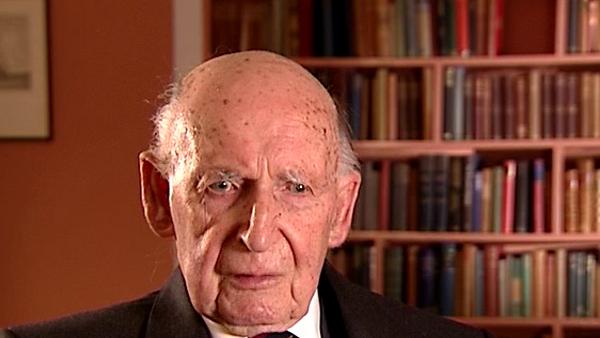NEXT STORY

Do meteors move in parabolic orbits around the Sun?
RELATED STORIES

NEXT STORY

Do meteors move in parabolic orbits around the Sun?
RELATED STORIES



There was a great dispute about the origin of meteors. It was well known that the... the so-called meteor showers, like the Perseids, were associated with the... with the comet in orbit around the sun of various periods, and... and in many cases, the debris from the comet was spread out around the orbit, such as the Geminids in mid-December. They're pretty regular. They give a... a rate of about... a visible rate of about 60 an hour and... and the Perseids are also pretty well spread over the orbit but in the case like Geminids and Leonids in November, the... the cometry debris is still rather closely associated with the comet, so they are relatively infrequent. In the case of the Leonids in November, I think their period is about 33 years. In the Geminids, it's about six or six and a quarter years.
Now, apart from these well-known shower meteors there is always a background of... of so-called sporadic meteors, and there was a tremendous dispute going on as to whether these shower... these sporadic meteors were confined to the solar system or were in hyperbolic orbits and visitors from in the solar space and I think, perhaps, apart from the Geminids observations, one of the most important things we did in those early days was to settle that dispute.
Now, it was Herlofson who suggested to us that we had the possibility of... of an accurate means of measuring the velocity of meteors because, of course, by eye is very difficult to... if you want to get them approximate velocity. So he said we... we were sending out 600 or 1,000 pulses per second from our radar and we should be able to observe the... the passage of the meteor through the Fresnel zone if we had arranged to spread out the pulses on a time base. Well, we made the necessary equipment to do this, in which the echo would trigger the camera and we would get a... a film, not just of the meteor streak but of the formation of the ionisation as it passed through Fresnel zone, maximum, minimum. And since we also had a measurement of the range, it was a perfectly simple matter to make a fairly accurate... well, a really very accurate measurement of the velocity of the meteor.
Now, the dispute arose because Öpik, when he... I think he was an Estonian and he had both in Estonia and when he had moved to America, had used what he called a rocking mirror method to observe the velocity of meteors and he had developed an enormous literature and quite... quite an abstract theory, in which he proved that all the shower... most of the sporadic meteors were moving in hyperbolic velocities around the sun and were therefore... that was therefore debris from interstellar space.
Bernard Lovell (1913-2012), British radio astronomer and founder of the Jodrell Bank Observatory, received an OBE in 1946 for his work on radar, and was knighted in 1961 for his contribution to the development of radio astronomy. He obtained a PhD in 1936 at the University of Bristol. His steerable radio telescope, which tracked Sputnik across the sky, is now named the Lovell telescope.
Title: Work at Jodrell Bank into the velocity of meteors
Listeners: Megan Argo Alastair Gunn
Megan Argo is an astronomer at the University of Manchester's Jodrell Bank Observatory researching supernovae and star formation in nearby starburst galaxies. As well as research, she is involved with events in the Observatory's Visitor Centre explaining both astronomy and the history of the Observatory to the public.
Alastair Gunn is an astrophysicist at Jodrell Bank Observatory, University of Manchester. He is responsible for the coordination and execution of international radio astronomical observations at the institute and his professional research concerns the extended atmospheres of highly active binary stars. Alastair has a deep interest and knowledge of the history of radio astronomy in general and of Jodrell Bank in particular. He has written extensively about Jodrell Bank's history.
Tags: Jodrell Bank, Perseids, Geminids, Leonids, Estonia, USA
Duration: 3 minutes, 30 seconds
Date story recorded: January 2007
Date story went live: 05 September 2008